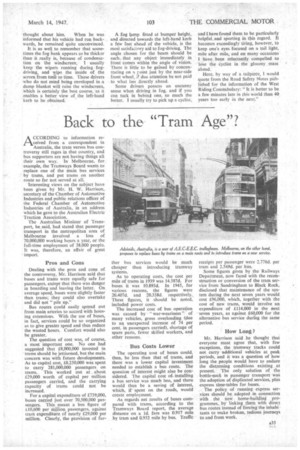Back to the "Tram Age"?
Page 53

If you've noticed an error in this article please click here to report it so we can fix it.
ACCORDING to information received from a correspondent in Australia, the tram versus bus controversy still rages in that country, and bus supporters are not having things all their own way. In Melbourne, for example, the Tramways Board wants to replace one of the main bus services by trams, and put trams on another route so far not served at all.
Interesting views on the subject have been given by Mr. H. W. Harrison, secretary of the Chamber of Automotive Industries and public relations officer of the Federal Chamber of Automotive Industries of Australia, in an address which he gave to the Australian Electric Traction Association.
The Australian Minister of Transport, he said, had stated that passenger transport in the metropolitan area of Melbourne involved a loss of 70.000,000 working hours a year, or the full-time employment of 38.000 people. It was, therefore, an affair of great import.
Pros and Cons Dealing with the pros and COM of the controversy, Mr. Harrison said that buses and trams were equally safe for passengers, except that there was danger in boarding and leaving the latter. On average speed, buses were slightly faster than trams; they could also overtake and did not "pile up."
Bus routes could easily spread out from main arteries to accord with housing extensions. With the use of buses, in fact, services could be so organized as to give greater speed and thus reduce the wasted hours. Comfort would also be greater.
The question of cost was, of course, a most important one. No one had suggested that £8,000,000 invested in trams should be jettisoned, but the main concern was with future developments. As to capital cost, £8,250,000 was spent to carry 281,000,000 passengers on trams. This worked out at . about 7E29,000 worth of capital per million passengers carried, and the carrying capacity of trams could not be increased.
For a capital expenditure of £739,000, buses carried just over 70,500.000 passengers. This meant a bus figure of £10,600 per million passengers, against tram expenditure of nearly £29,000 per million. Clearly, the provision of fur
ther bus services would be much cheaper than introducing tramway systems.
As to operating costs, the cost per mile of trams in 1939 was 14.587d. For buses it was 10.893d. In 1945, for various reasons, the figures were 20.407d. and 20.358d. respectively.. These figures, it should be noted, included power costs. The increased cost of bus operation was caused by " war-weariness " of many vehicles, gross overloading (due to an unexpected increase of 74 per cent, in passengers carried), shortage of spare parts, fewer skilled workers, and other reasons.
Bus Costs Lower
The operating cost of buses could, then, be less than that of trams, and there was a lower capital investment needed to establish a bus route. The question of interest might also be considered. The capital cost oU installing a bus service was much less, and there would thus be a saving of interest, which, if spent on the roads, would create employment.
As regards net results of buses compared with trams, according to the Tramways Board report, the average distance on a Id. fare was 0.917 mite by tram and 0.932 mile by bus. Traffic
receipts per passenger were 2.776d. per tram and 2.569d. per bus.
Some figures given by the Railways Department, now faced with the reconstruction or conversion of the tram service from Sandringham to Black Rock, disclosed that maintenance of the system during the next seven years would cost 06,000, which, together with the cost of new trams, would involve an expenditure of £114,000 in the next seven years, as against £60,000 for the alternative bus service during the same period.
How Long ?
Mr. Harrison said he thought that everyone must agree that, with few exceptions, the tramway tracks could not carry additional vehicles at peak periods, and it was a question of how long the people would have to endure the distressing conditions existing at present. The only solution of the bottle-neck in passenger transport was the adoption of duplicated services, plus express time-tables for buses.
The policy of running express services should be adopted in connection with the new home-building programmes, by linking them with direct bus routes instead of forcing the inhabitants to make broken, tedious journeys to and from work.




















































































